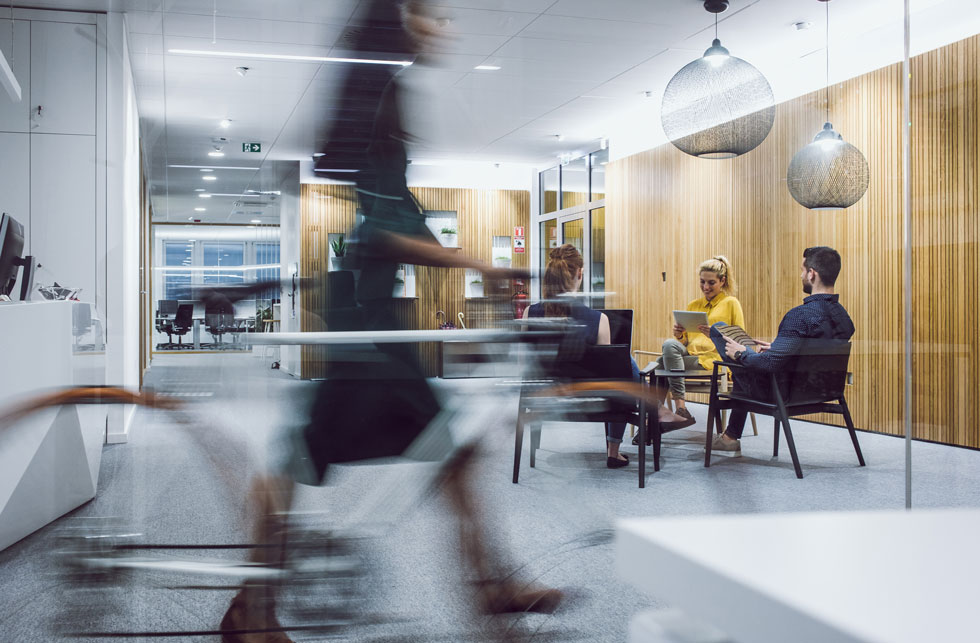REITs are seeing tenants looking to upgrade their space and create an environment that employees will want to come back to.
After more than two years of wondering whether the office market would ever revert to its pre-pandemic norm—or at least an approximation of it—owners of office space in the United States are getting answers.
A return to office is well underway across the country. As expected, many employees are working from home part of the week, typically Mondays and Fridays. And leasing activity continues to rebound: JLL reports that absorption turned positive in the fourth quarter of 2021 for the first time since the onset of the pandemic, and although leasing activity in the first quarter this year slowed due to the omicron variant, it still represented an improvement in tenant demand for the fifth consecutive quarter.
Data from Kastle Systems, a company that reports a weekly measure of building access security card swipes by its business partners in ten major cities, shows that average occupancy for the week to May 25 stood at 42.95%. Occupancy ranged from 33.61% in San Francisco to 58.54% in Austin, Texas.
How these trends look six, 12, or even 18 months from now remains a riddle. While companies like Blackstone and Facebook have charted their future space needs with big leases in Midtown Manhattan and Sunnyvale, California, respectively, many office users are still pondering how work-from-home policies, business growth, and the potential need to expand space between individuals to create healthier environments will influence their office needs.
“It’s going to take a significant period of time for office users to figure out the right cadence of people coming back to work as well as the utilization of their physical office space and human capital,” says Douglas Linde, president of BXP (NYSE: BXP), which owns 52.8 million square feet of office space in Boston, Los Angeles, New York, San Francisco, Seattle, and Washington, D.C. “Based on the labor market we find ourselves in at the moment, companies are focused on creating destinations their employees want to congregate at versus putting strict mandates in place.”
Determining the Right Size
In the first quarter of 2022, BXP signed 1.2 million square feet of leases and reported occupancy of 89.1%, a slight increase from the prior year. The REIT also executed more than 1.1 million square feet of leases in April alone. Still, building utilization trends ranged from 40% to 80%, with the lower and higher ends of the spectrum generally on the West and East coasts, respectively.
Similarly, Charlotte, North Carolina-based Highwoods Properties, Inc. (NYSE: HIW) leased 681,000 square feet in the first quarter this year, and its occupancy rate of 91.1% represented a year-over-year increase of 150 basis points. Office utilization of about 50% marked an improvement of 10 percentage points during the quarter, and executives expect it to accelerate based on return-to-work plans of their tenants.
One of the wild cards moving forward is to what extent employees engaged in counting, measuring, and other process-driven tasks will work from home, suggests Brian Leary, COO of Highwoods, which owns 27.4 million square feet of office space, primarily in eight markets, including Charlotte, Tampa, Florida, Atlanta, and Nashville, Tennessee.
“Companies need to determine exactly what the right size of their workforce is in this new technology-embedded environment,” Leary says. “If there are jobs that could be done just as well from home, then I think they could downsize at a rate that’s equivalent to their efforts to densify space prior to the pandemic, which was about 10% a year.”
Employee Edge
It could be argued that executives would prefer to have employees in the office every day of the work week. For example, only one in three of 2,300 senior managers support a prolonged period of hybrid schedules, according to a recent survey by Robert Half, a talent solution and business consulting firm. But, separate Robert Half research indicates that half of 1,000 professionals surveyed would look for a job that offered remote work options if their employer required a full-time return to the office.
Consequently, whatever office space calculation they make for the long term, at this moment in time, companies are most focused on ensuring employee satisfaction and retention given the competitive employment market. As of May, professional and business service companies had hired 821,000 more workers than they employed in February 2020, according to the Bureau of Labor Statistics. At the same time, unemployment remained at an historical low of 3.6%.
Considering the jobs market, it’s not surprising that 53% of companies had instituted a voluntary return to the office versus 31% that had required it, according to an early 2022 office occupier survey conducted by CBRE. What’s more, only 19% of respondents said they would insist that employees work in the office all week, a decline from about 30% a year earlier.
“If a company is being restrictive at either end of the spectrum—demanding that employees be in the office all of the time or remote all the time—they’re going to have an unhappy workforce,” says Julie Whelan, global head of occupier thought leadership with CBRE in Boston. “People want flexibility. Putting out strict policies that dictate behavior is going to fall flat across the workforce, regardless of age or life stage or generation.”
It’s going to take a significant period of time for office users to figure out the right cadence of people coming back to work as well as the utilization of their physical office space and human capital.
Slowdown Scenario
How long can this dynamic last before the pendulum swings in the favor of employers, perhaps by way of an economic slump, is an unknown at this point. In addition to rising inflation and interest rates, a negative 1.5% GDP estimate for the first quarter of 2022, and a yield curve inversion at the end of March, have fueled recession predictions.
On top of that, faltering technology earnings are fueling stock market losses. As a result, tech companies are instituting hiring freezes and laying off workers after going on a hiring spree over the last couple of years.
“Technology is a space that’s particularly exposed to inflation, and it’s usually the first industry to decline,” says Bradley Tisdahl, founder of Tenant Risk Management, a New York-based brokerage. “Whether we’ll see a real contraction in the industry or if this is just a result of capital markets volatility, time will tell.”
Together, however, these forces ultimately could provide employers with the leverage they need to require people to return to the office full time, or at least more of the time.
“It’s possible that as business conditions become more challenging, business leaders will feel a heightened sense of urgency to bring employees together on a much more consistent basis,” Linde says. “Being in the office becomes especially critical when integrating new employees who have been hired over the last two years but who have never met their boss or colleagues.”
Despite the potential economic turbulence, hybrid work is here to stay, Whelan counters. Many companies were already providing employees with flexible work schedules prior to COVID-19, she points out, and widespread remote working during the pandemic provided a generous amount of favorable productivity data. Unless evidence comes along that shows remote working is detrimental, it will be difficult to dent employee preference for a hybrid workplace, she adds.
“Even in a recessionary environment, those lessons learned don’t die, and if anything, companies are going to be more conscious about their real estate costs,” Whelan says. “This is just the evolution of work, which typically happens slowly, decade over decade. But we happen to be in a time where it has accelerated and become more apparent.”
Flight to Quality
Reluctant to cause discord among employees by demanding a return to the office, companies nevertheless are fearful that the inability to foster collaboration, train new workers, and maintain a certain culture in a hybrid workplace could threaten cohesion and profitability over the longer term.
To convince employees to come back to the office, companies are creating more appealing workplaces.
Just before the pandemic hit, for example, Cousins Properties (NYSE: CUZ) began redeveloping Buckhead Plaza, a two-building office and retail property in Atlanta totaling 666,000 square feet. Among other improvements, the project created a welcoming entry, more green space and patios that enable outside work, meetings and events, and upgraded common areas, corridors, and restrooms.
“Certainly, the flight to quality is real,” says Kennedy Hicks, an executive vice president for Atlanta-based Cousins, which owns 20 million square feet of office space in select Sun Belt markets. “In addition to the ongoing migration of companies to the Sun Belt, we’ve seen tenants looking to upgrade their space and create an office environment that employees will want to come back to.”
Despite a pause in leasing due to omicron, Cousins executed 324,000 square feet of leases in the first quarter. Figuring in additional leases signed in previous months that will commence later in 2022 and into 2023, the REIT’s portfolio is about 91% occupied. Most of that activity has occurred in properties built since 2010, which represents about 19% of Cousins’ portfolio.
While part of Cousins’ strategy centers on leveraging migration to Sun Belt markets, the flight to quality is also happening in the Northeast corridor and West Coast markets, Tisdahl points out.
“I’m not going to say leasing is back to normal by any stretch of the imagination, but momentum is building,” he says. “In New York, new buildings are generating interest, and older Class A inventory in places like Midtown is seeing leasing activity, too. But we haven’t seen any deals for Class B buildings yet.”
If a company is being restrictive at either end of the spectrum—demanding that employees be in the office all of the time or remote all the time—they’re going to have an unhappy workforce.
Focus on Experience
Other efforts to attract employees include enhancing human, digital, and physical amenities, Whelan says. These typically aim to improve the overall workplace experience by emphasizing indoor air quality and building wellness certifications, implementing the latest technology and smart building innovations, and incorporating outdoor meetings and gatherings as well as food-and-beverage events into the work week, she adds. Office landlords are eager to help.
The Hub, a 31-story office building connected to the Boston Garden, BXP helped Verizon design outdoor spaces on multiple floors, including a private roof deck roof deck on the 31st floor and a shared indoor-outdoor gathering space on the 8th floor, among other amenities, Linde says. The REIT is working with an on-site food hall to expedite delivery to the building, as well.
“Companies are rolling out the red carpet to encourage people to come back. They’re offering food-and-beverage in meaningful quantities and are creating outdoor spaces for activities that allow people to congregate and meet in bigger groups,” he explains. “Our focus is providing businesses with places that allow people to do their analysis work but that also encourage them to leave their desks and meet with others in attractive and enjoyable environments.”
Meanwhile, Highwoods has launched “Better Together,” an initiative in which it partners with tenants to create “transformative, innovative, distinctive, and collaborative” workplaces. Part of that strategy includes working with tenants that want to reconfigure their space and bolster amenities, Leary says. It also includes providing breakfast, lunch, and after-work hangouts and events. At its Bank of America Tower at Legacy Union in Charlotte, Highwoods recently secured a retail lease with Night Swim Coffee, a popular and fast-growing local coffee upstart.
“We’re reaching out and being proactive with a number of our customers in a variety of ways,” he explains. “We believe that if we can stimulate workers with caffeine or breakfast in the morning, nourish them at noon, and then lubricate them later with a drink, they will stay.”
Similarly, as part of its Buckhead Plaza redevelopment, Cousins Properties obtained an open-container license to enhance the options that tenants have when holding events in the upgraded outdoor areas, Hicks states.
“Companies want to do more team-building events that involve food-and-beverage to incentivize people to come back,” she says. “They also want to have the ability to hold meetings and work conversations outside.”
It remains to be seen whether these strategies, an economic slowdown that gives employers leverage, or a combination of the two will ultimately fill offices five days a week. Then again, time alone might convince employees to return full time, suggests John Poulos, executive vice president and managing director at SK Commercial Realty in Atlanta.
“Time heals all wounds,” he says. “Nobody would ride the elevator with someone else last fall, and six months later, I’m waiting for an elevator and there are 10 people in it when the door opens.”



